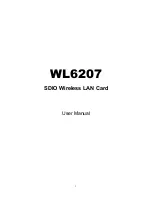
14
MANUAL P/N 900000111 REV K
antenna and NFS-220. In the event that a longer cable is required, a low loss cable must be used so
that the total signal attenuation at 1575 MHz is < 20 dB. For more information on suitable cables
contact Brandywine Communications.
q
Location
Several factors need to be considered when installing the GPS antenna. In most cases, the antenna
is mounted externally (outdoor) and exposed to the elements. A good quality coaxial cable of 50
ohm impedance is required to connect the GPS antenna to the NFS-220. The cable provides two
functions, which are to conduct the GPS RF signals (1575.42 MHz) that are received from the GPS
antenna to the NFS-220 and to conduct the DC bias voltage (5 VDC) provided by the NFS-220 to the
LNA (low noise amplifier) contained inside of the GPS antenna. The antenna should be mounted
securely, with a clear view of the sky, and with the top of the antenna pointing upward. In some
installations it may not be possible to mount the antenna such that the antenna has a clear 360
degree view of the sky. In such cases pick the location with the best view of the sky.
q
Exposure to High RF Fields
Some installations may occur in locations where a variety of high power transmitters and antennas
are located. The GPS antenna should not be directly exposed to or bombarded with high level RF
energy. In such cases, the antenna should be located either above, below, or to the side of these
high power RF transmission antennas.
q
Lightning Protection
The NFS-220 does not provide any inherent protection against lightning strikes. In general, lightning
protection (when desired or needed) is provided by an externally mounted protection device that is
designed to shunt the high voltage transient to a well established earth ground. Lightning arresting
devices designed for use with the GPS antenna system are available at Brandywine Communications
(P/N 001000914).
q
RF Loss
The most important source of signal loss is the RF signal attenuation experienced in the cable. The
amount of attenuation is related to the type (quality) of coaxial cable and cable length. The antenna
provides about 30 dB of gain to the received GPS signal. The purpose of this gain is to offset the
loss that is experienced in the cable between the GPS antenna and NFS-220. It is recommended
that the overall antenna system gain (antenna gain - cable loss) be between 10 dB - 33 dB. Using an
antenna with 30 dB of gain allows for about 20 dB of cable loss. The NFS-220 is shipped with 100’ of
Belden 8240 antenna cable with a cable loss of approximately 18 dB. For distances beyond 100’,
Brandywine recommends low loss Belden 9914 with a loss of 5.84 dB/100ft
Standard antenna cable using this configuration is available from Brandywine as shown in Table 4.
For distances beyond 330’, an in-line amplifier is required.
q
Tempest Facilities/Extremely Long Cable Runs
For applications where no conductive penetration of EMC shielding can be tolerated or for extremely
long cable runs, Brandywine Communications offers a remotely powered fiber optic antenna link.















































